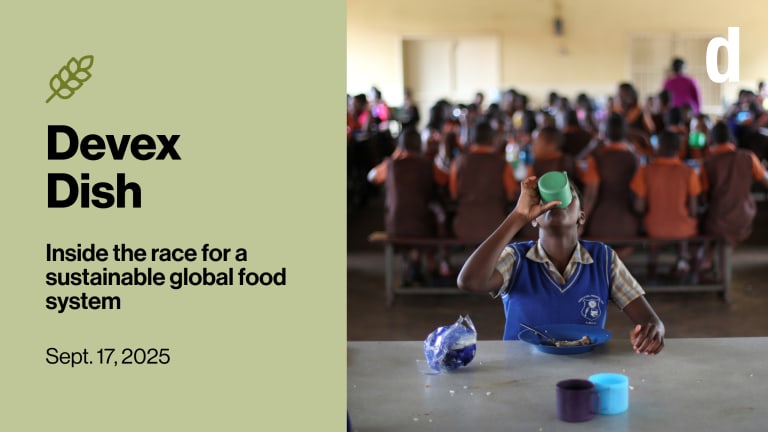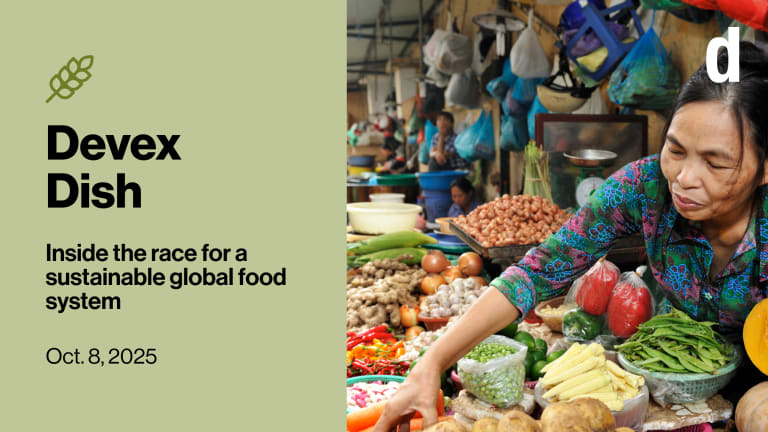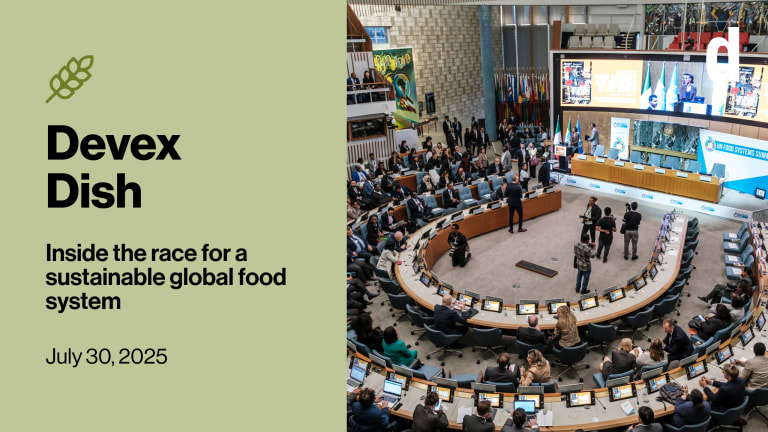
Following the takeover of the Taliban, humanitarian groups could more easily reach populations that they’d previously been unable to access while conflict was ongoing in Afghanistan. But fundraising gaps and international sanctions are making it close to impossible for WFP to meet the needs of the estimated 22.8 million people facing food insecurity.
This is a preview of Devex Dish
Sign up to this newsletter to get the inside track on how agriculture, nutrition, sustainability, and more are intersecting to remake the global food system in this weekly newsletter.
My colleague Shabtai Gold spoke with WFP’s Afghanistan country director while she was in Washington to lobby the U.S. government to change its sanctions regime, which is contributing to a liquidity crisis across Afghanistan. Mary-Ellen McGroarty told him that what she has witnessed there is unlike anything she’s seen before in her humanitarian work.
“In all my long career in WFP, I’ve seen this [situation] deteriorate, escalate, and implode at a pace and scale that just stunned me. Week on week, we’ve just seen it get worse,” McGroarty said.
She laid out the bleak conditions that her team is seeing while sounding the alarm about funding. “We run out of money by March. We have a shortfall of $1.9 billion,” she said.
An estimated 97% of the country is expected to live in poverty by the middle of 2022. People are skipping meals, selling belongings — and even selling their children.
And if WFP doesn’t get enough money to fund its operations this year? McGroarty predicts “starvation, death, migration, radicalization.”
Afghanistan: WFP’s country chief ‘terrified’ as hunger and despair mount
ICYMI: With so many people in danger of famine, the U.K. must spend aid funds in Afghanistan, former OCHA chief Mark Lowcock says.
Aid into Afghanistan is restricted because Western governments don’t want any money flowing to the Taliban. What do you think? What responsibility does the international community have to Afghan civilians? Are the sanctions justified? Write me at dish@devex.com.
Wake-up call
Despite its dire needs, Afghanistan comes in second among the countries with the highest numbers of food-insecure people this year, according to projections in WFP’s latest “Hunger Hotspots” report. First is the Democratic Republic of Congo, where 25.9 million people are facing acute levels of food insecurity, though that figure represents a “moderate improvement” from last year. Nigeria, Ethiopia, and Yemen round out the top five.
A mouthful
“We know what nutrition services we need to invest in and why they are important … But there has been insufficient focus on how to leverage [universal health coverage] platforms for nutrition outcomes.”
— Kyoko Shibata Okamura, nutrition specialist, World BankLast week, the World Bank and Global Financing Facility for Women, Children and Adolescents co-hosted a series of Nutrition for Growth side events focused on nutrition financing. One session that caught my attention argued that integrating nutrition into universal health coverage will be the only way for both agendas to meet their goals. According to Francesco Branca, director of the Department of Nutrition for Health and Development at the World Health Organization, 67% of the 396 new commitments announced at N4G related to health.
If you want to dive into the weeds on this, be sure to check out the new World Bank paper on how to optimize financing to align the health system with nutrition objectives, as well as how to address both financing and service delivery challenges.
Nutrition financing: Key to achieving universal health coverage
We’re excited to invite you to join us for the fourth edition of Prescription for Progress. On Feb. 15, we’ll gather once again — this year, virtually — to dive into insights on global health partnerships over the past year. Save your spot.
Full plates
Bringing home the bacon: Your next job?
Meat inspection expert for the review of regulation legal framework
International Executive Service Corps
Dominican Republic
My colleague Miguel Antonio Tamonan crunched the numbers to determine USAID’s top grantees for fiscal year 2021, which included agencies focused on food security. He found that $2.8 billion was obligated to WFP USA and $96.7 million to FAO.
Devex Pro subscribers can see the full list and how the agencies stack up to other multilaterals and NGOs.
+ Learn more about how USAID is furthering its localization agenda. Not yet a Pro subscriber? Sign up now and start your 15-day free trial.
Number munching
1.4 million
—That’s the number of people who may have to flee their homes in Somalia due to drought. According to the Norwegian Refugee Council, the country is currently seeing some of the lowest rainfall levels in 40 years. Numbers of malnourished children and deceased livestock are increasing as one-fifth of Somalia’s population — 3.2 million people — are affected by drought.
Chew on this
Sri Lanka will compensate more than 1 million rice farmers after their crops failed amid a bid to establish the world’s first 100% organic farming nation. [Al Jazeera]
Agriculture ministers from the Organisation for Economic Co-operation and Development and “several key partners” will meet in November to discuss sustainable agriculture and food systems. [OECD]
IFAD will publish a list of industries excluded from its investments and increase its investments in green bonds and other environmental, social, and governance securities. [IFAD]
Have you found Dish useful in your work? Please consider forwarding this issue to a colleague and encourage them to join our community by subscribing.









